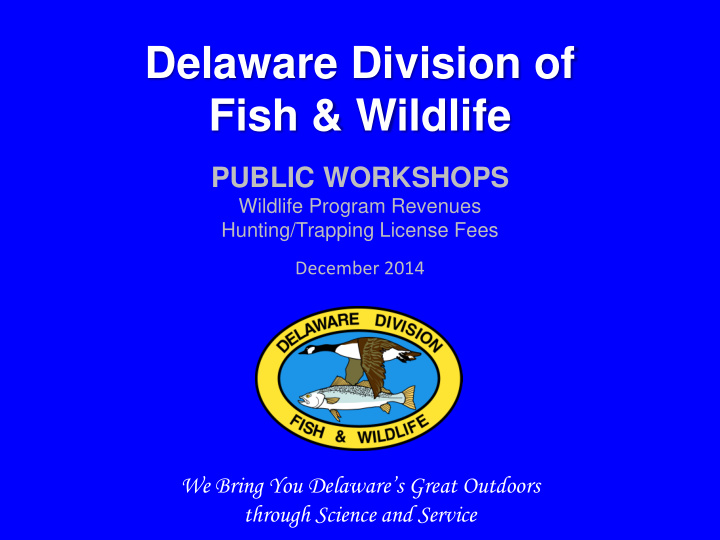



Delaware Division of Fish & Wildlife PUBLIC WORKSHOPS Wildlife Program Revenues Hunting/Trapping License Fees December 2014 We Bring You Delaware’s Great Outdoors through Science and Service
Agenda • Revenue and Fee Presentation • Questions • Comments Assawoman Wildlife Area
Hunters and trappers in Delaware generate approximately $4.2 million/year for wildlife management, research and public hunting lands through… • License Purchases • Federal Excise Taxes (Equipment) Hunters spend $61.7 million each year in Delaware, adding to the state’s economy and supporting 549 private sector jobs.
The Division provides wildlife program services to include: • Wildlife population and habitat management • Wildlife species and habitat research • Public wildlife areas for hunting, trapping and wildlife • Hunter education • Shooting sports facilities
Revenues Services Hunters and Hunters and 50-75% of Wildlife Trappers purchase Trappers Program operation licenses purchase hunting equipment revenues depend on hunting and Wildlife Programs trapping license use license Excise taxes from funds combined revenues to hunting equipment “match” Federal sales are deposited with matching Trust Funds for into Federal funds. projects Federal Trust Funds $1 State for every $3 Federal
License Fees 16% Federal Funds 54% General Fund/ Other 30%
Public Technical Assistance Administration Hunter 7% 3% Education & Public Shooting Range 17% Wildlife Area Operations Wildlife 48% Management & Research 25%
Total License Holders 20,500 • 16,860 licensed 20,000 hunters 19,500 19,000 18,500 18,000 • Generally a 3-8% 17,500 17,000 decrease/year 16,500 (exemptions, recruitment) 16,000 15,500 15,000 2004 2005 2006 2007 2008 2009 2010 2011 2012 2013 Last license fee increase was in 2007.
• Decrease in $1,600,000.00 license revenues $1,400,000.00 since 2008 $1,200,000.00 • Decrease in $1,000,000.00 General Funds $800,000.00 General since 2008 Funds $600,000.00 License • 20% inflation Revenue $400,000.00 over last 10 $200,000.00 years (less $- purchasing 2005 2006 2007 2008 2009 2010 2011 2012 2013 ability) Last license fee increase was in 2007.
Revenues • License increase in $3,000,000.00 dropped to 2007 generated 2007 level by 2011 approximately $2,500,000.00 $280,000 in additional revenue $2,000,000.00 • General Fund License Revenue $1,500,000.00 decrease beginning General Funds in 2008 resulted in $1,000,000.00 approximately $430,000 loss $500,000.00 • Net result of approximately $- 2007 2008 2009 2010 2011 2012 2013 $150,000 fewer state dollars available to Last license fee GF begin increase match Federal funds declining
Current hunting and trapping fee revenues are not sufficient to maintain the Wildlife Program’s current level of service and wildlife/habitat conservation. • Wildlife Program has had revenue shortfalls since 2009 due to decreased license revenues and General Fund reductions • $429,674 projected shortfall for FY15 (July 2014 - June 2015) • Prevents matching $1.29 million in Federal funds • Total lost funding opportunity = $1.72 million/yr
To reduce costs, the Wildlife Program has implemented : • Implemented accounting procedures generating $200,000/year in additional match to Federal funds • Service Reductions • Did not fill five full-time vacant positions • Hired 70% fewer seasonal employees for wildlife area management • Eliminated wildlife food plots and reduced sunflower plantings • Closed wildlife area access roads between hunting seasons • Reduced number of permit hunting days on wildlife areas • Reduced days/hours at the Ommelanden shooting range • Reduced other maintenance/operational activities at wildlife areas
New Fee Authority Granted by the 147 th General Assembly House Bill 425 Epilogue (excerpt with emphasis added): “Section 93. Revenues. The Department of Natural Resources and Environmental Control , following adequate opportunity for public comment and the approval of the appropriate public advisory council(s) and Secretary, may establish…such appropriate fees as shall approximate and reasonably reflect costs necessary to defray the expenses of each such activity or service…but no fee shall be charged for a purpose not specified in…the Delaware Code…” Woodland Beach Wildlife Area
Fee Process: • Opportunity for public comment • Consider public comment • Develop fee proposal for Wildlife Council • Wildlife Council votes on fee proposal December 9, 2014 at 6:30pm in the DNREC auditorium (in Dover) • Any fee increases would be effective July 1, 2015 Blackbird Reserve Wildlife Area
• Similar % increase for most license categories • Similar % increase for most resident and non-resident license categories • NO CHANGE for • Junior hunting license • Public Wildlife Area Deer Stand/Waterfowl Blind Lottery Permit Fun Facts: A successful hunting trip: PRICELESS!
Existing Fee New Fee License Type Amount Amount Resident Hunt (Age 16-64) $25.00 $45.00 Resident Junior Hunt (Age 13-15) $5.00 No Increase Resident Guide/Hunting (Age 16-64) $100.00 $225.00 Nonresident Hunt (Age 16 and Over) $130.00 $225.00 (Minimum of $130.00 or other state reciprocal value) Nonresident Junior Hunt (Age 13-15) $50.00 No Increase Nonresident 3-Day Hunt (Age 16 and Over) $50.00 $85.00 (3-Day not valid for Deer or Turkey) Nonresident Guide /Hunting (Age 16 and Over) $300.00 $525.00 Resident Hunters Choice/Quality Buck Tags $10.00 $20.00 Antlerless Tag $10.00 $20.00 Nonresident Quality Buck Tag $25.00 $50.00 Nonresident Antlered Tag $25.00 $50.00 Public Blind/Deer Stand Permit $20.00 No Increase Resident Waterfowl Stamp (Age 16-64) $9.00 $15.00 Nonresident Waterfowl Stamp (Age 16 and Over) $9.00 $15.00 Resident Fur Dealers $28.75 $60.00 Nonresident Fur Dealers $287.50 $450.00 Breeders Permit $11.50 $15.00 Propagating Permit $25.00 $40.00 Resident Trapping $3.50 $10.00 Nonresident Trapping $25.00 $75.00
• Balance budget • Restore services • Avoid further service reductions • Continue to provide wildlife conservation, research and management • Continue to manage public wildlife areas to provide access to hunters and trappers • Sustainable? Continue to evaluate fee revenues, program operations and wildlife user base
• Questions and comments are welcome. Please use the microphone provided. Comments limited to 3 minutes per person. • Questionnaire – Please complete and return questionnaire tonight.
Thank you for your input and support of wildlife conservation and hunting and trapping in Delaware! We Bring You Delaware’s Great Outdoors through Science and Service Ted Harvey Wildlife Area
Recommend
More recommend